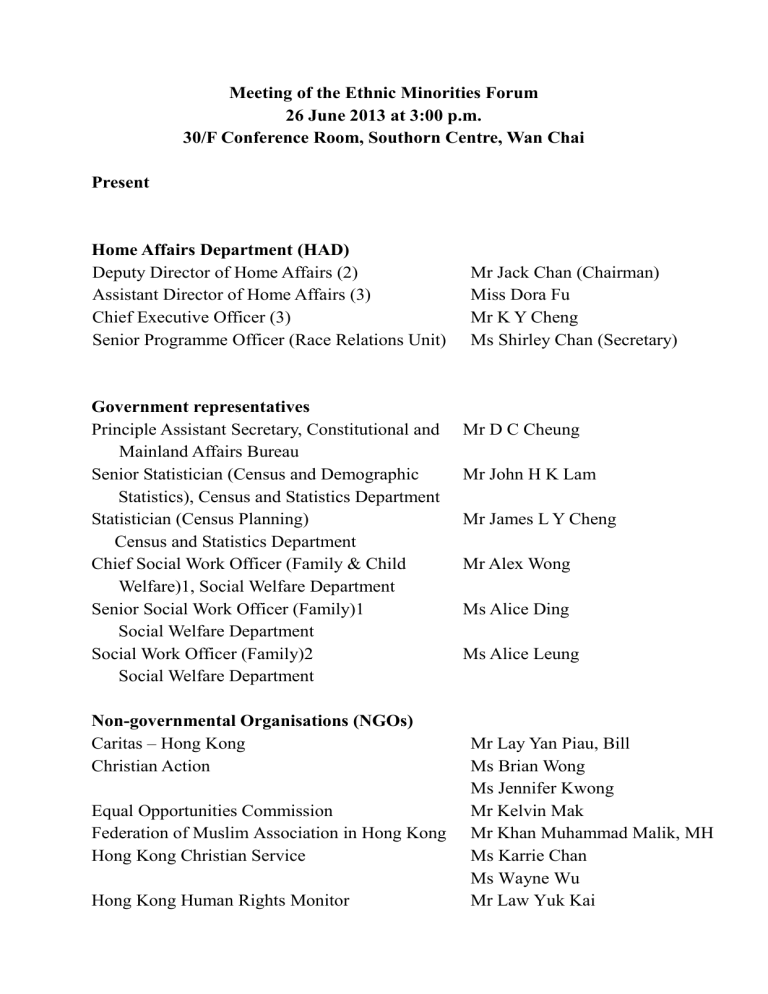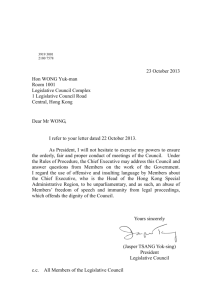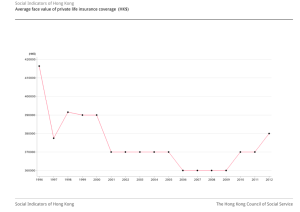Document

Meeting of the Ethnic Minorities Forum
26 June 2013 at 3:00 p.m.
30/F Conference Room, Southorn Centre, Wan Chai
Present
Home Affairs Department (HAD)
Deputy Director of Home Affairs (2)
Assistant Director of Home Affairs (3)
Mr Jack Chan (Chairman)
Miss Dora Fu
Chief Executive Officer (3) Mr K Y Cheng
Senior Programme Officer (Race Relations Unit) Ms Shirley Chan (Secretary)
Government representatives
Principle Assistant Secretary, Constitutional and
Mainland Affairs Bureau
Senior Statistician (Census and Demographic
Statistics), Census and Statistics Department
Statistician (Census Planning)
Census and Statistics Department
Chief Social Work Officer (Family & Child
Welfare)1, Social Welfare Department
Senior Social Work Officer (Family)1
Social Welfare Department
Social Work Officer (Family)2
Social Welfare Department
Mr D C Cheung
Mr John H K Lam
Mr James L Y Cheng
Mr Alex Wong
Ms Alice Ding
Ms Alice Leung
Non-governmental Organisations (NGOs)
Caritas – Hong Kong
Christian Action
Mr Lay Yan Piau, Bill
Ms Brian Wong
Ms Jennifer Kwong
Equal Opportunities Commission Mr Kelvin Mak
Federation of Muslim Association in Hong Kong Mr Khan Muhammad Malik, MH
Hong Kong Christian Service Ms Karrie Chan
Ms Wayne Wu
Hong Kong Human Rights Monitor Mr Law Yuk Kai
Hong Kong Integrated Nepalese Society
Hong Kong Nepalese Federation
Hong Kong SKH Lady MacLehose Centre
Idara Minhajul Quran Hong Kong
International Social Service – Hong Kong
Branch (ISS-HK)
ISS-HK (HOPE Centre)
Kirat Yakthung Chumlung
Mission for Migrant Workers
Neighbourhood Advice-Action Council (NAAC)
NAAC, TOUCH Sub-centre
New Home Association (NHA)
NHA (HOME Centre)
Nigerian Union Hong Kong
Southern Democratic Alliance
The Hong Kong Council of Social Service
The India Association Hong Kong
The Pakistan Association of Hong Kong Ltd.
United Filipinos in Hong Kong
Mr Buddhi Bahadur Thapa, MH
Mr Pradeep Thapa
Mr Lo Kai Chung
Mr Mohamed Ibramsa Sikkander
Batcha
Ms Adrielle M Panares, MH
Mr Deepen Thapa
Mr Umair Muhammad
Ms Bibi Ashma
Ms Bashna Limbue
Ms Samanatha Ale
Mr Fanjang Limbu
Ms Deepika Gupta
Mr Krishna Raj Limbu
Ms Cynthia C Abdon-Tellez
Ms Wong Mei Fung, Connie
Ms Mok Miu Ying
Ms Alveena Azrum
Mr Chan Yee Fei
Ms Fu Yim Ting, Jenny
Ms Chan Man Yam, Rachel
Ms Tehmina Khan
Mr Olak Bahadur Sunuwar
Mr Prince Chukwu Clement
Mr Saran Kumar Limbu
Ms Lynn Law
Mr Kavi Khiytani
Mr Zaman Minhas Qamar
Ms Dolores Balladares-Pelaez
2
1.
2011 Population Census – Thematic Report on Ethnic Minorities by
Census and Statistics Department
1.1 At the invitation of the Chairman, Mr Cheng (C&SD) presented a range of statistics on ethnic minorities (EMs) in Hong Kong, based on the results of the 2011 Population Census. A highlight of the characteristics of major EM groups, including Indonesians, Filipinos,
Thais, Pakistanis, Nepalese, Indians, other Asians, non-Asians, mixed and others was provided in the presentation.
1.2 Issues raised by attendees and the discussions were set out below:
1.2.1 In response to some attendees’ enquiry about a full copy of the 2011
Population Census Thematic Report: Ethnic Minorities, the Chairman asked the Secretariat to provide attendees with the hyperlink for downloading the report from the website of the Census and Statistics
Department (C&SD).
[Post-meeting note: On 1 August 2013, the Secretariat advised attendees that the 2011 Population Census Thematic Report: Ethnic
Minorities was available in the website of C&SD
( http://www.censtatd.gov.hk/hkstat/sub/sp170.jsp?productCode=B1120062 )].
(a) Statistical data quality
1.2.2 Some attendees considered that ethnic minorities had been undercounted in the 2011 Population Census (Census). To this end, service planning and policy formulation for some EM communities based on the census data had been insufficient. Mr Lam (C&SD) responded that the purpose of the Census was to obtain information on the demographic, socio-economic characteristics of the population of
Hong Kong. In the Census, the ethnicity of a respondent was determined by self-identification while the classification of ethnicity was determined with reference to a combination of concepts such as cultural origin, nationality, place of birth, length of residence and language.
3
1.2.3 An attendee opined that EM respondents should be explained with caution the distinction between nationality and ethnicity in the data collection process given that some EMs were of the same nationality but of different ethnicities. Some attendees suggested that C&SD should recruit EM interpreters to assist respondents of the same racial backgrounds in responding to the next Population By-census. An attendee proposed that, in future census, C&SD should consider selecting EM respondents at random from the districts with relatively high EM population. The EMs selected through a random sampling procedure should be given detailed interviews with language support services. Enumerators handling the target EM respondents should be trained with linguistic and cultural competence and briefed of the areas vulnerable to misclassification or errors.
1.2.4 Mr Lam (C&SD) explained that arrangements with regard to breaking language barriers were put in place in the 2011 Population Census to ensure the participation of EMs in the survey. Special arrangements included printing of multilingual posters, broadcasting in EM radio programmes, advertising on local newspapers in EM languages, printing of “short form” questionnaires in ten EM languages and the provision of interpretation service upon request during face-to-face interviews in the second phase of enumeration. Mr Lam added that
EM organisations would be consulted in the extensive consultation exercise of the 2016 Population By-census (By-census) with a view to collecting their views on the design of the By-census.
(b) Data categories
1.2.5 An attendee was concerned that the statistics of Filipinos, Indonesians and Thais were predominately categorised as foreign domestic helpers while the statistics of Southeast Asian permanent residents were not included in the presentation. Such approach might cause stereotyping placed on Southeast Asians in Hong Kong. Mr Lam explained that only the major ethnic groups were included in the presentation.
Statistics on other ethnic groups were also available from the Census.
As regards statistics on foreign domestic helpers, such figures were also
4
available from the administrative data of the Immigration Department.
(c) Request for additional data
1.2.6 Some attendees asked the findings of Africans, asylum seekers and right of abode in the 2011 Population Census. Mr Lam said that statistics on other ethnic groups were also available from the Census.
C&SD could provide the respective information upon request.
However, he added that the numbers of some special groups might be too small for supporting precise statistical analysis.
1.2.7 Some attendees requested C&SD to include particulars of language proficiency, income disparity, types of housing and household composition in respect of EMs in the next census analysis. Mr Lam explained that they had received requests for collecting additional data on the demographic profiles of different interest groups, such as people with disabilities, new arrivals, etc. C&SD would consider the feasibility of collecting any additional data via the population census/by-census taking into account various factors, in particular, a balance between respondent burden and data requirements from interest groups.
2.
Social Services for Ethnic Minorities by Social Welfare Department
2.1
At the invitation of the Chairman, Mr Wong and Ms Ding (SWD) gave a presentation on a range of support services for EMs provided by the
Social Welfare Department (SWD) and its subvented NGOs, including family services, services on prevention of domestic or sexual violence and child abuse, elderly services and children and youth services.
2.2
Issues raised by attendees and the discussions were set out below:
(a) Street sleepers
2.2.1
An attendee commented that some street sleepers of Nepalese origin stayed underneath the Ferry Street Flyover over six months and urged
SWD to render assistance to help them give up street sleeping. Mr
5
Wong (SWD) said that SWD had conducted a number of outreaching visits to identify the ten Nepalese street sleepers in the area. Out of the ten street sleepers, five accepted the provision of accommodation services and financial assistance through the subvented NGO. Two who were CSSA recipients and public housing tenants had been given counseling and services referrals. The remaining three were being approached by both the Salvation Army – Integrated Service Team for
Street Sleepers and the Society for Community Organisation - Care and
Support Networking Team, to assess their needs.
(b) Medical waivers
2.2.2 Some attendees asked whether foreign domestic helpers whose employment contracts had been terminated pending their return to home countries were eligible for medical fee waivers. Mr Wong explained that all residents could apply for fee waivers at public hospitals or clinics if they could not afford medical fees. Medical
Social Workers would assess the applications with due consideration given to the financial, social and medical conditions of the applicants.
Under special circumstances, some applicants who might not meet the financial and social criteria would be assessed on individual case merit to ensure that vulnerable groups in the community had access to proper medical care.
(c) Enhanced social welfare services for EMs
2.2.3
An attendee opined that social workers of subvented NGOs and non-subvented service units should be adequately trained to place greater emphasis on the communication barriers and cultural sensitivity in handling work relating to EMs. An attendee said that some front-line social workers were reluctant to provide interpretation services for EM service users, particularly for drop-in services, and sometimes referred EMs to HAD’s Support Service Centres for EMs which were tasked to make referrals to relevant departments for follow-up actions.
2.2.4
Mr Wong explained that SWD had engaged service contractors to
6
provide EM service users with interpretation services either on the site or through a 3-way video conference whereby a real time conversation could be arranged among a social worker, an interpreter and an EM service user. SWD would remind social workers of the proper procedure in handling EM service users who might require interpretation services on a regular basis. On the sensitivity training,
SWD had been providing cultural sensitivity training for its and NGOs’ staff to enhance their capacity and sensitivity in handling work relating to EMs. More than 400 social workers had received training programmes for working with specific target groups, such as EMs, in the past three years.
2.2.5
Some attendees suggested that SWD should consider employment of
EM staff to facilitate EM service users in accessing the social welfare service. Mr Wong explained that NGOs funded under the Lump Sum
Grant subvention system were given flexibility to employ EM staff having regard to the service needs.
2.2.6
An attendee considered that education was the key to upward mobility.
In his view, the school social workers should strengthen support to non-Chinese speaking students and students with disabilities to ensure their equal opportunities in education. Mr Wong said that SWD attached great importance to school social work services to help students’ learning opportunities and academic achievements, irrespective of their racial and social backgrounds. In 2011, SWD had increased the subvention on school social work by over 20%.
(d) Forced marriages
2.2.7
An attendee raised concern about forced marriages among attendees of
EM communities. He suggested that SWD should develop special measures to deal with victims of forced marriage which would become one of the most prevalent forms of domestic violence. Mr Wong responded that they had handled cases of domestic violence from EM families but there was no specific record on cases of forced marriages.
Currently, the Police adopted a multi-disciplinary approach and would make referral of domestic violence cases to SWD for further assistance
7
to the victims. Workshops in collaboration with the Police on topics such as how to prevent and report domestic violence were regularly organised for EM communities.
2.2.8 Some attendees offered the following suggestions -
(a) The numbers of EM users in services for youth, family, elderly and community should be collected to identify their service needs and in printing their publications with a view to ensuring that language was not a barrier for EMs to access social welfare services.
2.2.9 Mr Wong thanked attendees’ suggestions and would explore the feasibility of taking the suggestions forward.
3.
improvement options;
(b) SWD should work in close collaboration with HAD’s Support
Service Centres for Ethnic Minorities and NGOs that serve EMs to strengthen the referral network and provision of culturally sensitive social welfare services for EMs; and
(c) SWD should examine the extent to which EM languages were used
New Support Service Centre and Sub-centres for Ethnic Minorities by the New Home Association and the Neighbourhood
Advice-Action Council
3.1 With the aid of Powerpoint presentations, the representatives of the
HOME Centre and TOUCH Sub-centre briefed attendees on the latest position of the support services for EMs provided by both Centre and
Sub-centres, details of which were set out in the information paper no.
01/2013.
3.2 An attendee complimented the efforts of the Government and the
Centres in facilitating EMs to integrate into the society. He volunteered to promote the services to the Nepalese community.
3.3 Ms Panares (ISS-HK) informed attendees that a full team of ambassadors attended at the meeting to understand the services provided by the HOME Centre and TOUCH Sub-centre. Ambassadors
8
would reach out to the EM communities and introduce to them the services provided by the Centre and Sub-centres.
4.
Any other business:
There being no other business, the meeting ended at 6:00 pm.
Home Affairs Department
December 2013
9








